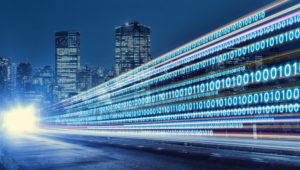

(lassedesignen/Shutterstock)
As data continues to pile up, enterprises that maintain flexible approaches to managing and mining that data are the ones most likely to achieve competitive success, according to Gartner, which recently released its top 10 analytics technologies and trends for 2019.
The Global Datashere currently measures 33 zettabytes, according to a recent IDC report, and is predicted to grow to 175 zettabytes by 2025. Navigating this data deluge is no simple matter, as the volume and velocity exceeds the capabilities of existing data analytics rigs running atop legacy architectures.
“The size, complexity, distributed nature of data, speed of action, and the continuous intelligence required by digital business means that rigid and centralized architectures and tools break down,” explains Donald Feinberg, vice president and distinguished analyst at Gartner. “The continued survival of any business will depend upon an agile, data-centric architecture that responds to the constant rate of change.”
So, just what composes an “agile, data-centric architecture”? That, of course, is the $64,000 question. Nobody knows for sure, of course, but Feinberg and other Gartner analysts took a gander at the topic, and shared what they believe to be the top 10 data analytics and technology trends that will be making headlines in 2019. (Spoiler alert: Blockchain hype appears to be fading fast.)
Top 10 Tech
The number one analytics tech trend on Gartner’s list is augmented analytics, which the analyst firm describes as the use of machine learning and AI to transform how analytics content is developed, consumed, and shared.
“By 2020, augmented analytics will be a dominant driver of new purchases of analytics and BI, as well as data science and ML platforms, and of embedded analytics,” Gartner writes. “Data and analytics leaders should plan to adopt augmented analytics as platform capabilities mature.”
The augmented theme continued with number two on the list: augmented data management. Gartner says that ML and AI technologies are impacting how enterprises manage data quality, integration, metadata, and master data.
“It is automating many of the manual tasks and allows less technically skilled users to be more autonomous using data,” the company writes. “It also allows highly skilled technical resources to focus on higher value tasks.
Continuous intelligence is the third major trend. Also known as real-time analytics, this trend encompasses all activities related to harnessing “real-time context data” to improve decision making.
AI has an explainabilty problem, as we’ve documented in these virtual pages on more than one occasion. That’s why breaking the “black box” nature of complex ML and deep learning models is so critical, and why Gartner made it number four on its list.
Graph analytics isn’t new, but the technologies and techniques behind graph are very well aligned to solving the big data challenges enterprises face today and in the future. Thanks to graph analytics’ capability to allow you to ask “complex questions across complex data,” Gartner sees graph growing at a healthy 100% CAGR clip through 2022.
Number six on Gartner’s list is big data fabrics, which represent an emerging way to establish consistency across diverse and distributed data environments. However, the static nature of today’s bespoke data fabric architectures will necessarily give way to more dynamic approaches, which will necessitate redesigns, the analyst firm predicts.
Like chatbots? So does Gartner, which sees big things for the future of natural language processing and conversational interfaces. Fueled by big data collections and neural networking advances, Gartner says 50% of analytical queries will run through a NLP, voice, or search interface by 2020.
Data scientists predominantly conduct their ML and AI work via open source software platforms today. But by 2022, 75% of that work will be done using commercial solutions, predicts the Gartner.
Okay, blockchain is still on Gartner’s radar, thanks to the “significant ramifications” for analytics use cases. But at number nine of the 10 most impactful analytics technologies and trends, it’s fair to say that Gartner isn’t too bullish on blockchain’s short term impact.
Rounding out the top 10 is persistent memory servers, which Gartner defines as “representing a new memory tier between DRAM and NAND flash memory that can provide cost-effective mass memory for high-performance workloads.”
We have been watching the capabilities of in-memory databases and in-memory data grids (IMDGs) advance in the past few years. With more data than ever to process, enterprises are welcoming the bigger memory and storage tiers, to go along with today’s speed processors.
Keeping up with technology trends is not easy in the analytics world. It wasn’t long ago that analysts were praising the idea of big centralized clusters (hello, Hadoop?) that could house all of an enterprise’s data. But today, enterprises are looking at bringing a much more diverse and distributed set of tools and technologies to bear on the ever-growing morass of data that sits before them.
“The story of data and analytics keeps evolving, from supporting internal decision making to continuous intelligence, information products and appointing chief data officers,” Rita Sallam, research vice president at Gartner, said during the Gartner Data & Analytics Summit last week in Sydney, Australia. “It’s critical to gain a deeper understanding of the technology trends fueling that evolving story and prioritize them based on business value.”
Related Items:
Data Growth Rate in U.S. Predicted to Slow
What Gartner Sees In Analytic Hubs
Gartner Sees AI Democratized in Latest ‘Hype Cycle’
July 3, 2025
- FutureHouse Launches AI Platform to Accelerate Scientific Discovery
- KIOXIA AiSAQ Software Advances AI RAG with New Version of Vector Search Library
- NIH Highlights AI and Advanced Computing in New Data Science Strategic Plan
- UChicago Data Science Alum Transforms Baseball Passion into Career with Seattle Mariners
July 2, 2025
- Bright Data Launches AI Suite to Power Real-Time Web Access for Autonomous Agents
- Gartner Finds 45% of Organizations with High AI Maturity Sustain AI Projects for at Least 3 Years
- UF Highlights Role of Academic Data in Overcoming AI’s Looming Data Shortage
July 1, 2025
- Nexdata Presents Real-World Scalable AI Training Data Solutions at CVPR 2025
- IBM and DBmaestro Expand Partnership to Deliver Enterprise-Grade Database DevOps and Observability
- John Snow Labs Debuts Martlet.ai to Advance Compliance and Efficiency in HCC Coding
- HighByte Releases Industrial MCP Server for Agentic AI
- Qlik Releases Trust Score for AI in Qlik Talend Cloud
- Dresner Advisory Publishes 2025 Wisdom of Crowds Enterprise Performance Management Market Study
- Precisely Accelerates Location-Aware AI with Model Context Protocol
- MongoDB Announces Commitment to Achieve FedRAMP High and Impact Level 5 Authorizations
June 30, 2025
- Campfire Raises $35 Million Series A Led by Accel to Build the Next-Generation AI-Driven ERP
- Intel Xeon 6 Slashes Power Consumption for Nokia Core Network Customers
- Equal Opportunity Ventures Leads Investment in Manta AI to Redefine the Future of Data Science
- Tracer Protect for ChatGPT to Combat Rising Enterprise Brand Threats from AI Chatbots
June 27, 2025
- Inside the Chargeback System That Made Harvard’s Storage Sustainable
- What Are Reasoning Models and Why You Should Care
- Databricks Takes Top Spot in Gartner DSML Platform Report
- LinkedIn Introduces Northguard, Its Replacement for Kafka
- Change to Apache Iceberg Could Streamline Queries, Open Data
- Agentic AI Orchestration Layer Should be Independent, Dataiku CEO Says
- Why Snowflake Bought Crunchy Data
- Fine-Tuning LLM Performance: How Knowledge Graphs Can Help Avoid Missteps
- Top-Down or Bottom-Up Data Model Design: Which is Best?
- The Evolution of Time-Series Models: AI Leading a New Forecasting Era
- More Features…
- Mathematica Helps Crack Zodiac Killer’s Code
- ‘The Relational Model Always Wins,’ RelationalAI CEO Says
- Confluent Says ‘Au Revoir’ to Zookeeper with Launch of Confluent Platform 8.0
- DuckLake Makes a Splash in the Lakehouse Stack – But Can It Break Through?
- Solidigm Celebrates World’s Largest SSD with ‘122 Day’
- The Top Five Data Labeling Firms According to Everest Group
- Supabase’s $200M Raise Signals Big Ambitions
- Toloka Expands Data Labeling Service
- With $17M in Funding, DataBahn Pushes AI Agents to Reinvent the Enterprise Data Pipeline
- Databricks Is Making a Long-Term Play to Fix AI’s Biggest Constraint
- More News In Brief…
- Astronomer Unveils New Capabilities in Astro to Streamline Enterprise Data Orchestration
- Databricks Unveils Databricks One: A New Way to Bring AI to Every Corner of the Business
- Seagate Unveils IronWolf Pro 24TB Hard Drive for SMBs and Enterprises
- Gartner Predicts 40% of Generative AI Solutions Will Be Multimodal By 2027
- BigBear.ai And Palantir Announce Strategic Partnership
- Astronomer Introduces Astro Observe to Provide Unified Full-Stack Data Orchestration and Observability
- Databricks Donates Declarative Pipelines to Apache Spark Open Source Project
- Deloitte Survey Finds AI Use and Tech Investments Top Priorities for Private Companies in 2024
- Code.org, in Partnership with Amazon, Launches New AI Curriculum for Grades 8-12
- Databricks Announces Data Intelligence Platform for Communications
- More This Just In…




























